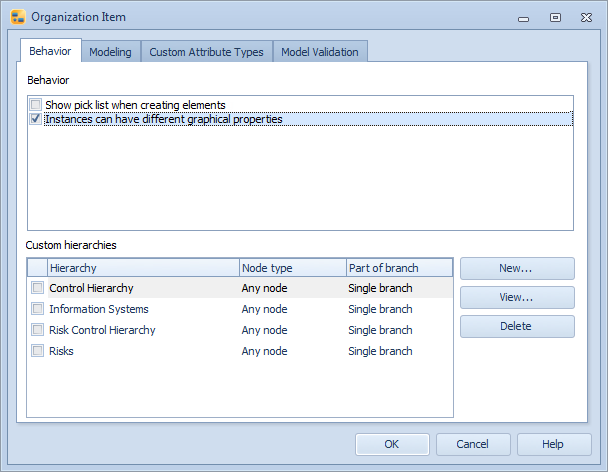Organization Item Modeling Properties |

|

|

|
||
Organization Item Modeling Properties |

|

|

|

|
|
|
||
In the Organization Item dialog, you can define the behavior and the custom attribute types of the current model's organization items. This dialog can be opened from the Modeling Options dialog by selecting "Organization Item" and clicking the "View" button.
Behavior
The Behavior tab shows the predefined behavior options for the organization item and the custom hierarchies in the model.
You can select the desired behavior options for the organization item by clicking a checkbox next to the behavior option. The behavior options are:
•Show pick list when creating elements: when this selection is enabled, creating instances of organization items can be done by selecting the name of an existing organization item from the drop-down menu displayed on a newly created organization item.
•Instances can have different graphical properties: when this selection is enabled, changing the graphical properties of an instance does not apply the change to every instance of the element.
Element hierarchies
The element hierarchies can be used, for example, to model the structure of the model. The element hierarchies are visible in sub-tabs of the Processes tab in QPR Portal. In case the model containing the custom hierarchy is a base model, the hierarchy is published if an organization item that is a part of the hierarchy is published. The "Custom hierarchies" list shows all the custom hierarchies in the model. The list is used to define element hierarchy behavior for the organization item type. The list contains four parts:
•Checkbox: selecting a checkbox will make the organization item type a part of the hierarchy in question.
•Hierarchy: this column lists the names of the element hierarchies in the model.
•Part of branch: the drop down boxes in this column define if the organization item can be a part of a single branch (i.e. the organization item can have only one parent element) or multiple branches (i.e. the organization item can have multiple parent elements).
•Node type: defining the node type as a "leaf node" prevents the organization items of this type from having child elements, whereas defining the node type as "any node" allows the organization items of this type to have child elements.
To create a new element hierarchy, click the New button. To view and modify the properties of an existing hierarchy, click the View button. Click Delete to delete the selected hierarchy.
Modeling
The Modeling tab shows the default graphical properties for the organization item. Click the Edit... button to modify the graphical properties.
Custom Attribute Types
Custom attribute types can also be defined for Organization items. On the Custom Attribute Types page of this dialog, you can add custom attribute types by clicking the "Add" button and remove custom attribute types with the "Remove" button. You can also edit the custom attribute types. To change the order of the custom attribute types, use the upward and downward arrow buttons on the right side of the dialog. You can edit the name of the custom attribute type by typing it into the Name column. The cardinality can also be changed by clicking on the cardinality value and then selecting a new value from the drop-down list (either 1 or N). If you select 1, only one value can be defined for that attribute. If you select N, several values can be defined.
If the Metamodeling Browsing feature has been enabled by your license, the number of elements (of this particular type) having values for the attribute type is shown in its own column. You can view more detailed usage information by clicking the Information... button.

Organization Item dialog
![]()
![]()
Model Validation
On the Model Validation tab, you can define validation rules to help you with model consistency and following a modeling notation. When the check box is filled, the validation definition set in Modeling Options Dialog are used. When the check box is checked, the validation definition on the current element type dialog is used. See the Modeling Options Dialog topic for details.